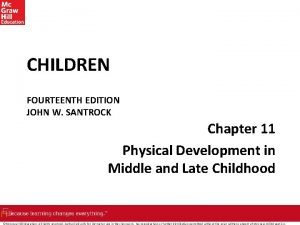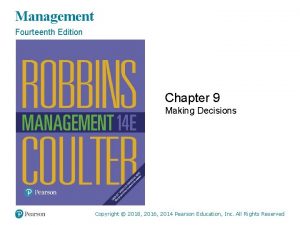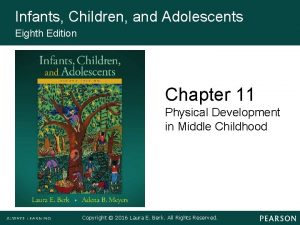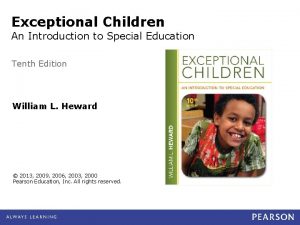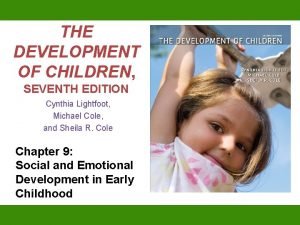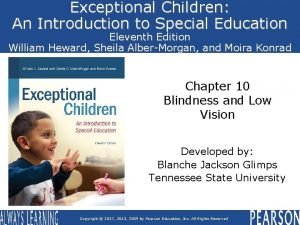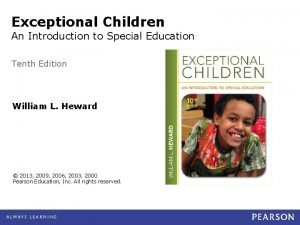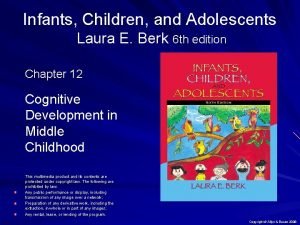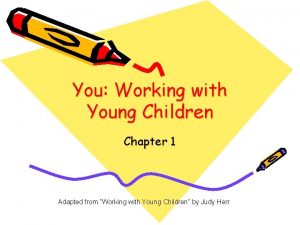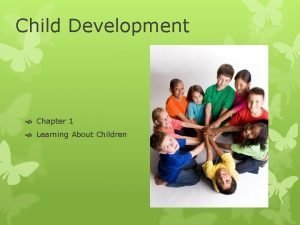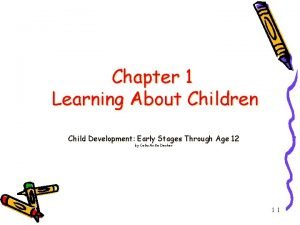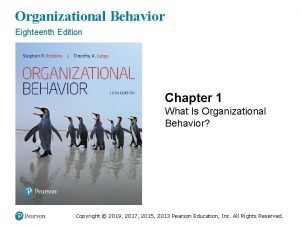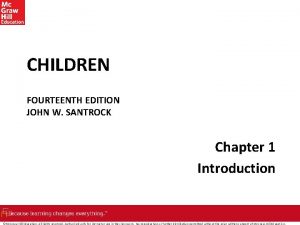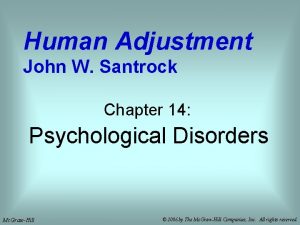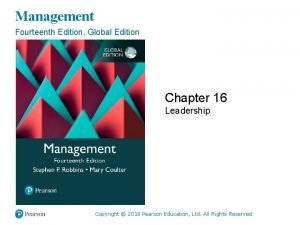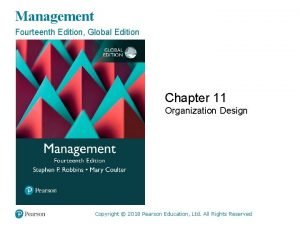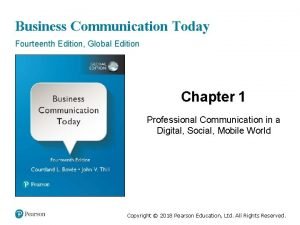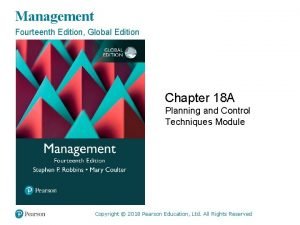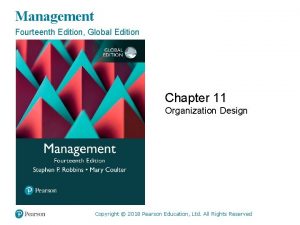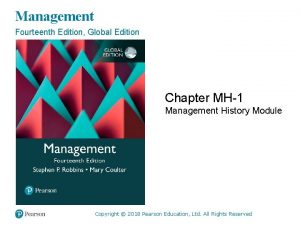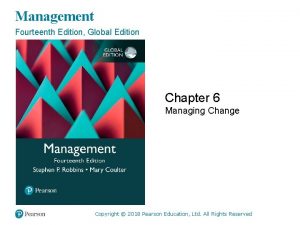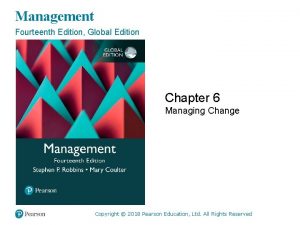CHILDREN FOURTEENTH EDITION JOHN W SANTROCK Chapter 11























- Slides: 23

CHILDREN FOURTEENTH EDITION JOHN W. SANTROCK Chapter 11 Physical Development in Middle and Late Childhood ©Mc. Graw-Hill Education. All rights reserved. Authorized only for instructor use in the classroom. No reproduction or further distribution permitted without the prior written consent of Mc. Graw-Hill Education.

Learning Goals Discuss changes in body growth, the brain, and motor development in middle and late childhood Characterize children’s health in middle and late childhood Summarize information about children with disabilities ©Mc. Graw-Hill Education.

Changes in the Skeletal and Muscular Systems Slow, consistent growth • During the elementary years, children grow 2 to 3 inches per year • In the middle and late childhood years, they gain 5 to 7 pounds per year, mainly due to muscular and skeletal changes Proportional changes are among the most pronounced physical changes in middle and late childhood • Head circumference, waist circumference, and leg length decrease in relation to body height • One less noticeable change: continued bone ossification ©Mc. Graw-Hill Education.

Changes in the Brain Increased myelination is linked to faster, more effective processing of information Brain volume stabilizes, but other changes continue • Prefrontal circuitry and pathways increase, linked to increased attention, reasoning, and cognitive control • Increased cortical thickness Activation of some brain areas increases while that of others decreases, a shift characterized by synaptic pruning ©Mc. Graw-Hill Education.

Changes in Motor Development Smoother movement and better coordination • Activity helps refine developing skills • Mastered skills become source of pleasure Boys are usually better in gross motor skills Hands are used more as “tools” and are steadier by age 7 • Age 8 to 10: more independent with hands • Fine motor skills in writing develop • Age 10 to 12: manipulative skills similar to those of adults ©Mc. Graw-Hill Education.

Age Motor skills Figure 2 Changes in Motor Skills During Middle and Late Childhood ©Mc. Graw-Hill Education. 6 Children can skip. Children can throw with proper weight shift and step. Girls and boys can vertically jump 7 inches. Girls can do a standing long jump of 33 inches, boys 36 inches. Children can cut and paste. Children enjoy making simple figures in clay. 7 Children can balance on one foot without looking. Children can walk 2 -inch-wide balance beams. Children can hop and jump accurately into small squares. Children can participate in jumping jack exercise. Girls can throw a ball 25 feet, boys 45 feet. Girls can vertically jump 8 inches, boys 9 inches. Girls can do a standing long jump of 41 inches, boys 43 inches. 8 Children can engage in alternate rhythmic hopping in different patterns. Girls can throw a ball 34 feet, boys 59 feet. Girls can vertically jump 9 inches, boys 10 inches. Girls can perform a standing long jump of 50 inches, boys 55 inches. Children’s grip strength increases. Children can use common tools, such as a hammer. 9 Girls can throw a ball 41 feet, boys 71 feet. Girls can vertically jump 10 inches, boys 11 inches. Girls can perform a standing long jump of 53 inches, boys 57 inches. Children’s perceptual-motor coordination becomes smoother. 10 Children can judge and intercept pathways of small balls thrown from a distance. Girls can throw a small ball 49 feet, boys 94 feet. Girls can vertically jump 10 inches, boys 11 inches.

Central Issues in Children’s Health: Nutrition Average child’s body weight doubles in middle and late childhood Food consumption increases with age • • Age 1 to 3: needs 1, 300 calories per day Age 4 to 6: needs 1, 700 calories per day Age 7 to 10: needs 2, 400 calories per day Needs also vary with size and activity level Healthy, balanced meals are most important ©Mc. Graw-Hill Education.

Diseases 1 Four childhood diseases that are especially harmful to children’s development are cancer, diabetes, cardiovascular disease, and asthma Cancer is the second leading cause of death in U. S. children aged 5 to 14 • Spreads to distant parts of the body faster in children • Little is known about the causes • May be a genetic component ©Mc. Graw-Hill Education.

Diseases 2 Diabetes is one of the most common chronic diseases in children and adolescents • Type I is an autoimmune disease • Type II is the most common; the body creates insulin but not enough, or the body is unable to use it • Type II risk factors include being overweight and/or physically inactive, having relatives with this disease, or belonging to certain ethnic groups Cardiovascular disease is uncommon in children • Inactive lifestyle “sows the seeds” for later development ©Mc. Graw-Hill Education.

Diseases 3 Asthma is a chronic lung disease that involves episodes of airflow obstruction • Most common childhood chronic disease • Incidence has steadily increased over the years • Exact causes are unknown, but it is believed that it results from hypersensitivity to environmental substances that triggers an allergic reaction • Treated with inhalers and medications • Physical activity is a possible protective factor against asthma development ©Mc. Graw-Hill Education.

Prevalent Disabilities in Children In the U. S. , 12. 9% of children aged 3 to 21 Receive special education or related services • • • 4. 6% have learning disabilities 2. 7% have speech, language impairments 1. 0% receive an autism diagnosis 0. 9% are diagnosed with an intellectual disability 0. 7% have an emotional disturbance Educators prefer “children with disabilities, ” not “handicapped children” ©Mc. Graw-Hill Education.

The Range of Disabilities: Learning Disabilities 1 Learning disability: difficulty in learning that involves understanding or using spoken or written language • Difficulty can appear in listening, thinking, reading, writing, spelling, or math • Not primarily the result of visual, hearing, or motor disabilities, intellectual disabilities, emotional disorders, or environmental, cultural, or economic disadvantage Three times as many boys as girls are classified as having a learning disability ©Mc. Graw-Hill Education.

The Range of Disabilities: Learning Disabilities 2 Most learning disabilities are lifelong • Can grow up to lead normal and productive lives • Diagnosis is a difficult task, as guidelines vary Most common areas: reading, writing, and math • Dyslexia: reading and spelling • Dysgraphia: handwriting difficulties • Dyscalculia: math/number difficulty ©Mc. Graw-Hill Education.

The Range of Disabilities: Learning Disabilities 3 Learning disabilities tend to run in families • Genetics may play a role Some learning disabilities are likely caused by problems during prenatal development or delivery Learning disabilities are likely due to problems integrating information from multiple brain regions or to subtle defects in brain structure and function Successful interventions involve intensive instruction over a period of time by a competent teacher ©Mc. Graw-Hill Education.

The Range of Disabilities: ADHD In attention deficit hyperactivity disorder (ADHD), children show one or more of the following: inattention, hyperactivity, and impulsivity For a diagnosis, the characteristics must be debilitating Number of diagnoses has increased substantially Disorder occurs four to nine times more often in boys Signs may be present during the preschool years, but children are usually not classified until the elementary years • Treated with medications and behavioral management • Causes are suspected but not confirmed • Neurofeedback and mindfulness might improve attention • • ©Mc. Graw-Hill Education.

The Range of Disabilities: Speech Disorders Speech disorders include articulation disorders, voice disorders, and fluency disorders • Articulation disorders: problems pronouncing sounds correctly • Voice disorders: reflected in speech that is hoarse, harsh, too loud, too high-pitched, or too low-pitched • Fluency disorders: stuttering Speech therapy is recommended ©Mc. Graw-Hill Education.

The Range of Disabilities: Sensory Disorders 1 Serious visual impairments affect about 1 in 1, 000 children • Low vision: a visual acuity of between 20/70 and 20/2000 with corrective lenses (20/20 is normal); reading is possible with large print or a magnifying glass • Educationally blind: vision cannot be used in learning; affects 1 in every 3, 000 children • Many children who are educationally blind have normal intelligence • Function very well academically with appropriate supports ©Mc. Graw-Hill Education.

The Range of Disabilities: Sensory Disorders 2 Hearing impairments can make learning difficult • Children who are born deaf or experienced hearing loss early in life may not develop normal speech and language • Many children go undiagnosed • Signs include turning one ear toward the speaker, needing things repeated, failing to follow instructions, and frequently complaining of ear aches, colds, etc. • Oral approaches to education include using lip reading and speech reading • Manual approaches to education involve sign language and finger spelling ©Mc. Graw-Hill Education.

The Range of Disabilities: Physical Disorders Many children with physical disorders require special education as well as related services • Orthopedic impairments: restrictions in movement abilities due to muscle, bone, or joint problems • Cerebral palsy: involves a lack of muscular coordination, shaking, and unclear speech ©Mc. Graw-Hill Education.

The Range of Disabilities: Emotional and Behavioral Disorders and Autism Emotional and behavioral disorders: persistent problems with relationships, aggression, depression, fears, and other inappropriate characteristics Autism Spectrum Disorders (ASD) are characterized by problems with social interaction, verbal and nonverbal communication, and repetitive behaviors • Autistic disorder: a severe developmental disorder • Boys are four times more likely to have autistic disorder • Asperger syndrome: relatively mild • Children with autism show some deficits in cognitive processing of information ©Mc. Graw-Hill Education.

Educational Issues 1 Public Law 94 -142: the Education for All Handicapped Children Act (1975) • Requires that all children with disabilities be given a free, appropriate public education • Provides the funding to help with the costs of implementing this education • In 1990, recast as the Individuals with Disabilities Education Act (IDEA) • Spells out broad mandates for providing services to all children with disabilities ©Mc. Graw-Hill Education.

Educational Issues 2 IDEA was amended in 1997 and reauthorized in 2004 • Aligned with No Child Left Behind (NCLB) • Alternate assessments for students with disabilities were included in the 2004 reauthorization • Children must be evaluated before a school can provide special services • Individualized Education Plan (IEP): a program tailored to the child’s specific needs • Under IDEA, a child with a disability must be educated in the least restrictive environment (LRE), a setting similar to that of other learners • Inclusion: full-time education in the regular classroom ©Mc. Graw-Hill Education.

Review Discuss changes in body growth, the brain, and motor development in middle and late childhood Characterize children’s health in middle and late childhood Summarize information about children with disabilities ©Mc. Graw-Hill Education. All rights reserved. Authorized only for instructor use in the classroom. No reproduction or further distribution permitted without the prior written consent of Mc. Graw-Hill Education.
 Children john santrock
Children john santrock Management fourteenth edition
Management fourteenth edition Tricotomico
Tricotomico Human adjustment santrock
Human adjustment santrock Fourteenth amendment
Fourteenth amendment Summer of his fourteenth year poem
Summer of his fourteenth year poem Gains in perspective taking permit the transition to
Gains in perspective taking permit the transition to Infants and children 8th edition
Infants and children 8th edition Exceptional children 10th edition
Exceptional children 10th edition The development of children 7th edition
The development of children 7th edition The development of children 7th edition
The development of children 7th edition Introduction of exceptional child
Introduction of exceptional child Exceptional children 10th edition
Exceptional children 10th edition Lara berk
Lara berk Infants and children 8th edition
Infants and children 8th edition Mis chapter 6
Mis chapter 6 Mis
Mis Working with young children/answer key chapter 1
Working with young children/answer key chapter 1 Child development chapter 1
Child development chapter 1 Chapter 1 learning about children
Chapter 1 learning about children Organizational behavior 18th edition
Organizational behavior 18th edition Pericyclic
Pericyclic Mechanics of materials 7th edition solutions chapter 10
Mechanics of materials 7th edition solutions chapter 10 Mechanics of materials 9th edition solution chapter 7
Mechanics of materials 9th edition solution chapter 7
